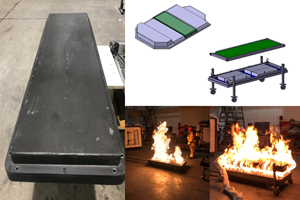AZL opens new project in cell-to-pack composite battery enclosures
AZL specialists are to kick off new project consortium Oct. 27, 2022 geared toward developing new battery enclosure concepts for cell-to-pack technology. Interested companies can still apply for participation.
Comparison of battery casing in modular design and “cell-to-pack” design. Photo Credit, all images: The AZL
As batteries for electric vehicles (EVs) become more performant, higher volumetric energy density plays a crucial role. If more energy is to be stored in less installation space, new material and design solutions are required. The development of suitable enclosures made of safe and highly robust lightweight materials is also required. A project led by the Aachen Centre for Integrative Lightweight Production (AZL, Aachen, Germany) on cell-to-pack battery enclosures for battery-electric vehicles will start in October of this year to address these challenges.
“Battery enclosures are a key component in EVs. In various collaborative projects, AZL is holistically investigating the challenging requirements and developing concepts on how plastic-based multi-material solutions can save weight and costs compared to status quo metal solutions,” Peter Dill, director Product Portfolio Global at Röchling Automotive (Mannheim, Germany), says. Dill is among the partners that AZL GmbH brings together across all value chains and material categories. “Working together in the consortium allows us to exchange creative ideas and brings new impulses, such as on the possibilities of new materials in terms of crash and fire protection. We at Röchling Automotive are already looking forward to the next project, which this time will focus on cell-to-pack housings.”
The cell-to-pack project, which is starting now, will focus on developing concepts for structural components and for producing them based on a variety of materials and design approaches. The concepts will be compared in terms of performance, weight and production costs, creating new know-how for OEMs, producers and their suppliers throughout the battery vehicle value chain. Companies are now invited to participate in this new cross-industry project to develop battery enclosure concepts for the cell-to-pack technology.
The basis for the project is the lightweight engineering expertise of the AZL experts, which has already been demonstrated in previous projects for multi-material solutions for module-based battery housings. Together, with 46 industry partners, including Audi, Asahi Kasei, Covestro, EconCore, Johns Manville, Teijin Ltd., DSM, Faurecia, Hutchinson, Magna and Marelli, 20 different multi-material concepts were optimized in terms of weight and cost and compared with a reference component made from aluminum. All production steps were modeled in detail to obtain reliable cost estimates for each variant.
According to the AZL, depending on the concept, 20% weight or 36% cost savings potential could be identified by using multi-material composites compared to the established aluminum reference.
The AZL expects that the design concept of battery enclosures will develop in the direction of a more efficient layout. In this case, the cells are no longer combined in modules in additional production steps, but are integrated directly into the battery housing. The elimination of battery modules and the improved, weight-saving use of space could enable higher packing density, reduced overall height and cost savings. In addition, various levels of structural integration of the battery housing into the body structure are expected.
These new designs are said to bring specific challenges, including ensuring protection of the battery cells from external damage and fire protection. In addition, different recyclability and repair requirements may significantly impact future designs. How the different material and structural options for future generations of battery enclosures for the cell-to-pack technology might look like and how they compare in terms of cost and environmental impact will be investigated in the new project, the AZL notes. In addition to the material and production concepts from the concept study for module-based battery enclosures, results from a currently ongoing benchmarking of different materials for the impact protection plate and a new method for determining mechanical properties during a fire test will also be incorporated.
The project will start on October 27, 2022 with a kick-off meeting of the consortium. Interested companies can still apply for participation until then.
Companies with interest in the development of battery casings should contact Philipp Fröhlig and Warden Schijve:
- Philipp Fröhlig | AZL Aachen GmbH | senior project manager | Tel.: +49 241 475 735 14 | Mobile: +49 176 804 88799 | Email: philipp.froehlig@azl-aachen-gmbh.de
- Warden Schijve | AZL Aachen GmbH | design leader | Tel: +49 241 475735 17 | Mobile: +49 177 512 97 80 | Email: warden.schijve@azl-aachen-gmbh.de
Related Content
Infinite Composites: Type V tanks for space, hydrogen, automotive and more
After a decade of proving its linerless, weight-saving composite tanks with NASA and more than 30 aerospace companies, this CryoSphere pioneer is scaling for growth in commercial space and sustainable transportation on Earth.
Read MoreThe state of recycled carbon fiber
As the need for carbon fiber rises, can recycling fill the gap?
Read MorePlant tour: Joby Aviation, Marina, Calif., U.S.
As the advanced air mobility market begins to take shape, market leader Joby Aviation works to industrialize composites manufacturing for its first-generation, composites-intensive, all-electric air taxi.
Read MorePrice, performance, protection: EV battery enclosures, Part 1
Composite technologies are growing in use as suppliers continue efforts to meet more demanding requirements for EV battery enclosures.
Read MoreRead Next
CW’s 2024 Top Shops survey offers new approach to benchmarking
Respondents that complete the survey by April 30, 2024, have the chance to be recognized as an honoree.
Read MoreFrom the CW Archives: The tale of the thermoplastic cryotank
In 2006, guest columnist Bob Hartunian related the story of his efforts two decades prior, while at McDonnell Douglas, to develop a thermoplastic composite crytank for hydrogen storage. He learned a lot of lessons.
Read MoreComposites end markets: Energy (2024)
Composites are used widely in oil/gas, wind and other renewable energy applications. Despite market challenges, growth potential and innovation for composites continue.
Read More



















.jpg;maxWidth=300;quality=90)








